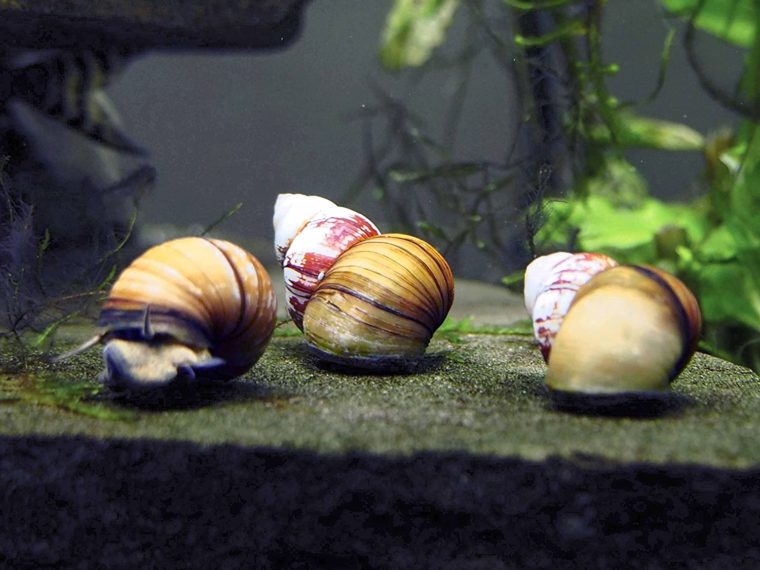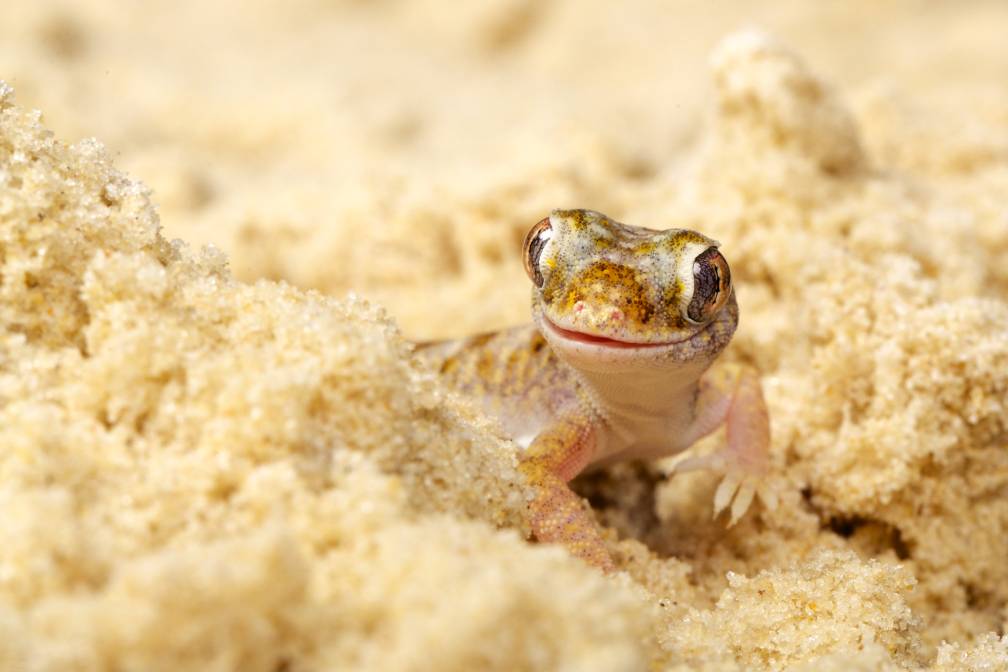
The Japanese Trapdoor snail is a beautiful and unique snail that many people love for keeping plants and tank surfaces free of algae growth. They are easy to care for, and many people even find these snails to be easy to breed if desired. Their peaceful nature makes them a great addition to a variety of tank environments.
Quick Facts About Japanese Trapdoor Snails
| Species Name: | Cipangopaludina japonica |
| Family: | Viviparidae |
| Care Level: | Easy |
| Temperature: | 68–85°F |
| Temperament: | Peaceful |
| Color Form: | Brown, tan, green, gold |
| Lifespan: | 5–10 years |
| Size: | 1–2 inches |
| Diet: | Omnivorous |
| Minimum Tank Size: | 10 gallons |
| Tank Set-Up: | Freshwater planted tanks |
| Compatibility: | Peaceful community fish, peaceful invertebrates |
Japanese Trapdoor Snail Overview
The Japanese Trapdoor snail naturally lives in freshwater rivers and lakes, with many even being found in rice paddies in Japan. While they are native to Japan, they have become established in a variety of freshwater bodies of water in the Eastern United States. In Minnesota, they are considered an invasive species and their ownership is restricted. They have become well-established in Lake Erie. They were introduced to the Great Lakes in the 1940s as a food source for the Channel catfish.
They grow faster lengthwise than they do in width, giving them a longer adult length compared to their shell width than other closely related snails. This, coupled with their whorled shells, makes them easy to identify.
In the wild in Asia, these snails are known to serve as a host for certain parasites that can impact human health. However, this danger does not seem to extend to the aquarium trade, especially when dealing with captive-bred snails. There has also been no evidence to date indicating they are a host to any parasites that pose significant dangers to humans in the United States.
How Much Do Japanese Trapdoor Snails Cost?
These snails are often quite affordable, but they may be somewhat difficult to find in big box pet stores. Oftentimes, Japanese Trapdoor snails start around $3–5 each, although they may run as high as $10–15 per snail, depending on the size and quality of the animal. If you are ordering Japanese Trapdoor snails from an online shop, expect to spend upwards of $35 on shipping a live animal.
Typical Behavior & Temperament
Japanese Trapdoor snails are extremely peaceful animals that are not a risk to other animals in your tank. Some people report them eating live plants, but they are more likely to eat dead plants or loose plant matter on plant leaves. When provided with regular food options, they are unlikely to consume live plants.
They spend most of their time eating algae on surfaces in the tank, especially on plant leaves and tank walls. They are also great at patrolling the bottom of the aquarium in search of leftover food, making them a useful addition to most tanks.
Appearance & Varieties
Every Japanese Trapdoor snail is unique! While they all have a pointed spiral shell, the exact shape and color vary widely between each animal. They tend to have shells that are more natural colors, like tan, brown, gold, and green. They may also show up in colors like reddish-brown, off-white, and gray.
They all have an operculum attached to the bottom of their foot. The operculum is a hard, shell-like attachment that allows them to fully pull their body into their shell and protect the tender areas from danger.
How to Take Care of Japanese Trapdoor Snails
Habitat, Tank Conditions & Set-Up
Japanese Trapdoor snails are relatively hardy snails once established. However, they are prone to dying shortly after arriving in a new environment due to stress and sudden changes in water parameters. Drip acclimation and slow introductions are ideal for preventing problems with adjusting to a new tank.
Tank Size
Japanese Trapdoor snails are somewhat large snails, but they can be a good addition to tanks as small as 10 gallons. It is not recommended to keep them in tanks smaller than this, though, since they can add to the bioload of a nano tank, making it difficult for the filtration to keep up and maintain water quality.
Water Quality & Conditions
These snails can tolerate a lower pH than many other varieties of snail, preferring a pH between 6.5–8.0, and they should be kept in water that is anywhere from soft to medium-hard. They prefer temperate to tropical temperatures from 68–85°F. They should be kept in a tank with no ammonia or nitrites, and the nitrate levels should ideally be kept less than 20ppm, although some people have success with nitrate levels as high as 40ppm.
Substrate
Any substrate is appropriate for Japanese Trapdoor snails. Sand and other fine substrates are ideal, though, as they allow waste and food to collect on top of the substrate. This allows the snails to pick up snacks from the floor of the tank instead of waste slipping into the substrate to rot.
Plants
Although Japanese Trapdoor snails don’t routinely consume live plants, they have been known to. It is best to provide a densely planted tank that these snails cannot deplete if being fed properly. Plants with thick, sturdy leaves, like Anubias, are less likely to be eaten than plants with soft, tender leaves.
Lighting
While the Japanese Trapdoor snail doesn’t have special lighting needs, lighting should be considered when keeping a planted tank. Knowing the lighting requirements for your plants will help you determine what lighting you should keep in your snail’s tank.
Filtration
Even though the Japanese Trapdoor snail is a good tank cleaner, filtration is still necessary to maintain high water quality. Your tank’s filter should be rated for the size of your tank, and if the tank is overstocked, then you’ll need a higher-rated filtration system.
Are Japanese Trapdoor Snails Good Tank Mates?
The Japanese Trapdoor snail is an extremely peaceful aquarium inhabitant, making them great tank mates for a variety of fish and invertebrates. They may eat deceased tank mates but will not harm or consume live tank mates.
Since they are peaceful and slow-moving animals, tank mates of the Japanese Trapdoor snail should not be rough or attempt to eat the snails. Examples of poor tank mates include Goldfish and aggressive Cichlid species. Peaceful community fish, like most Tetras, Otocinclus, Plecostomus, and Kuhli loaches, are good options, as are other invertebrates, like Mystery snails and Neocaridina shrimps.
What to Feed Your Japanese Trapdoor Snail
One of the top mistakes people make with these and other snails is not feeding them. While they do eat algae and leftover food in the tank, it is important to ensure your Japanese Trapdoor snails are getting plenty to eat by offering things like snail food, fish food, bottom feeder food, fresh fruits and vegetables, and even the occasional high protein treat like bloodworms.
Keeping Your Japanese Trapdoor Snail Healthy
As long as they are fed properly and kept in healthy water parameters, Japanese Trapdoor snails can live upwards of 10 years. Maintaining a healthy tank environment is the key. Ensure your Japanese Trapdoor snail is not being bullied or attacked by tank mates, is being fed properly, and is living in a healthy tank with properly managed water parameters. Rapid swings in pH and temperature, as well as the presence of ammonia and nitrites, can be detrimental to the health of your Japanese Trapdoor snail.
Breeding
If you have a healthy tank environment and both a male and female Japanese Trapdoor snail, they are almost guaranteed to eventually breed, although they cannot do so until they are around 1 year of age. Unlike many other varieties of snails, the Japanese Trapdoor snail cannot reproduce without a mate and reproduces slowly and in small numbers, so there’s essentially no risk of these snails taking over your tank.
They are viviparous snails, which means they give birth to live young. Females can carry between 10–120 young in a single clutch.
Are Japanese Trapdoor Snails Suitable for Your Aquarium?
The Japanese Trapdoor snail is a gentle and beneficial addition if you keep a freshwater tank with peaceful inhabitants. These snails are not ideal to keep with rough tank mates that may pick at them, but they do well with peaceful and small tank mates.
Japanese Trapdoor snails can be used to help keep a tank clean due to their love of soft algae. They’ll consume it from a variety of surfaces, and they’re big fans of eating leftover food and detritus off the bottom of the tank. They’re also ideal for the average tank because they reproduce slowly and are unlikely to take over your tank with their offspring.
Featured Image Credit: Amazon








